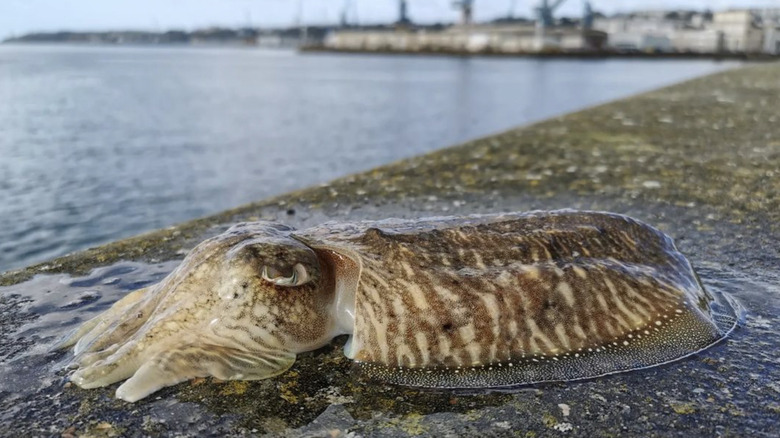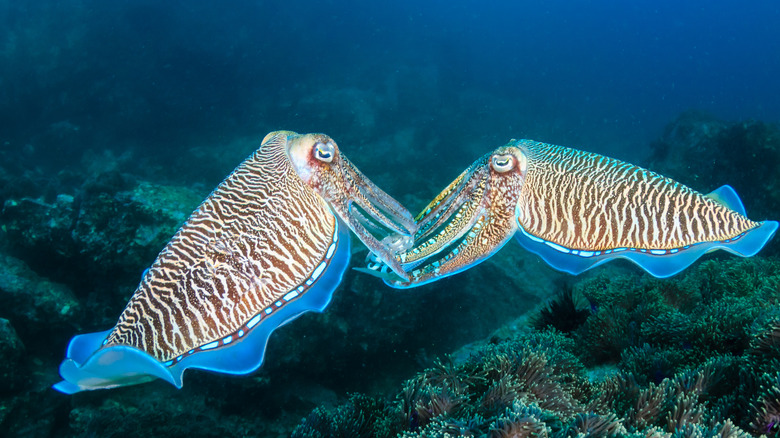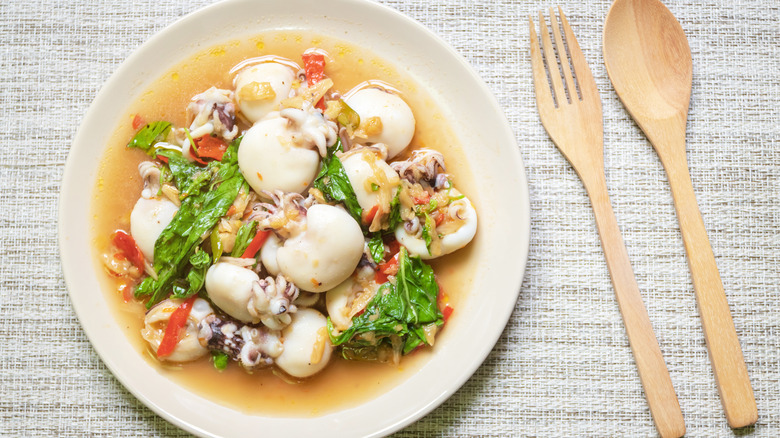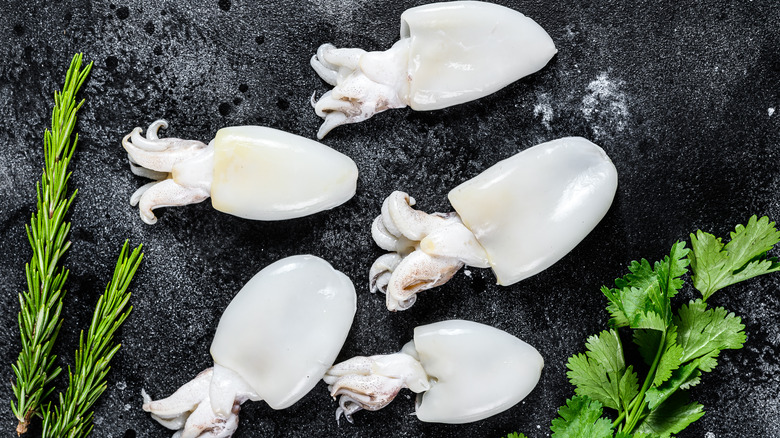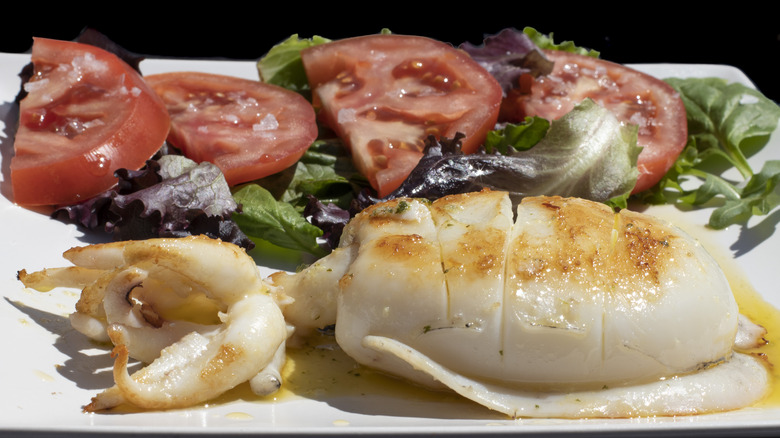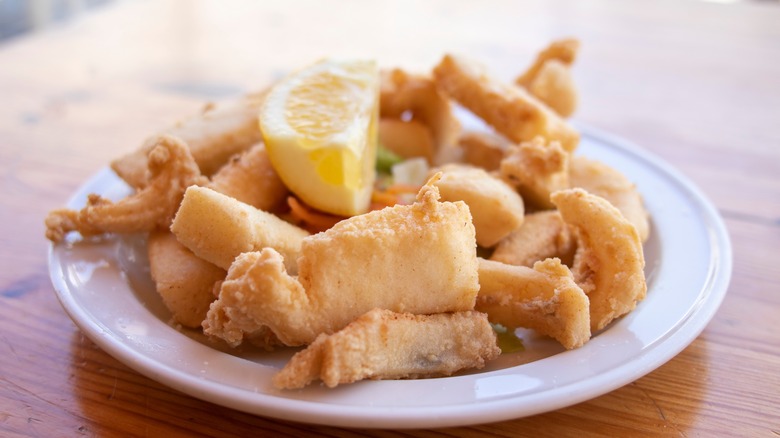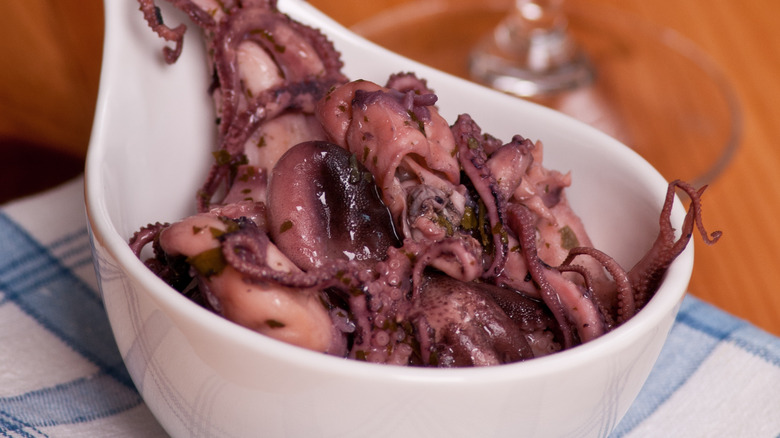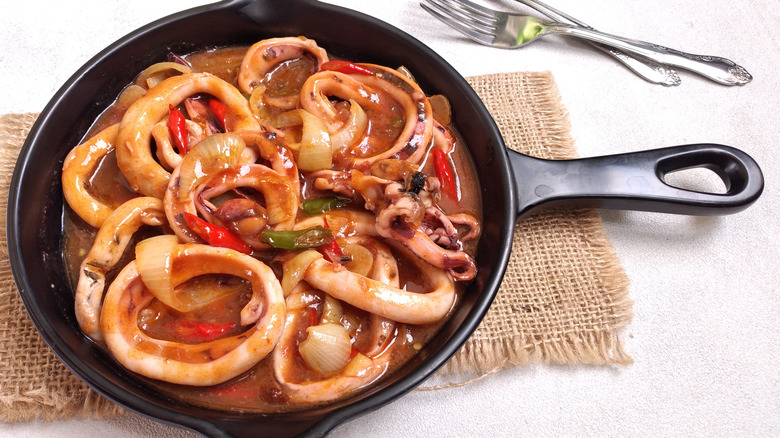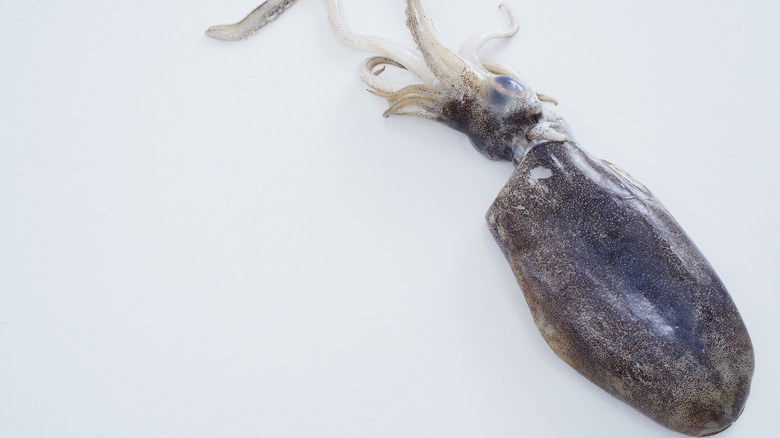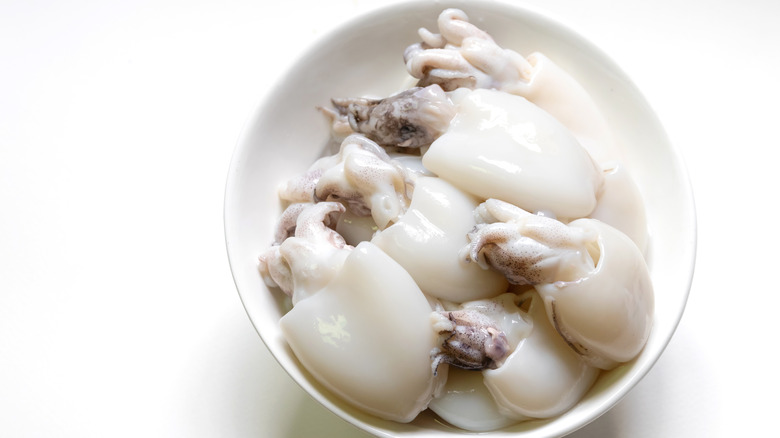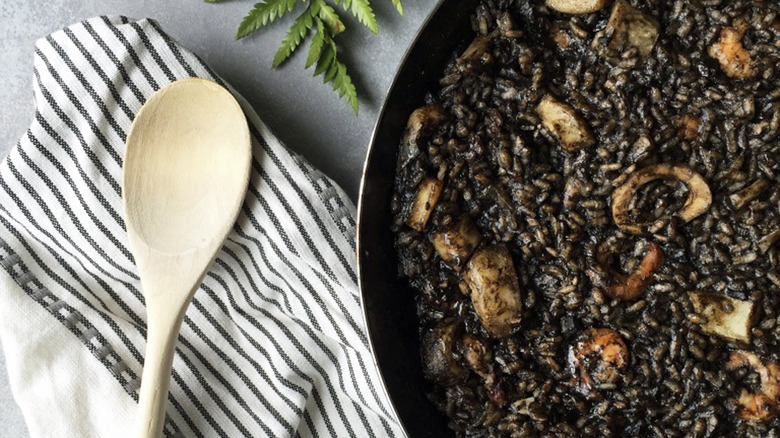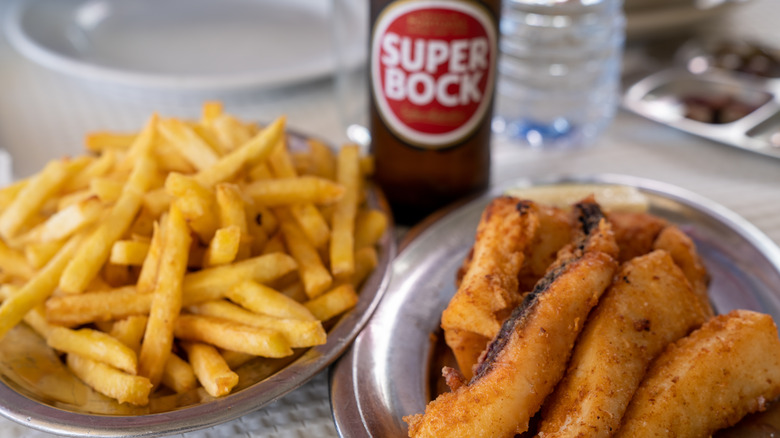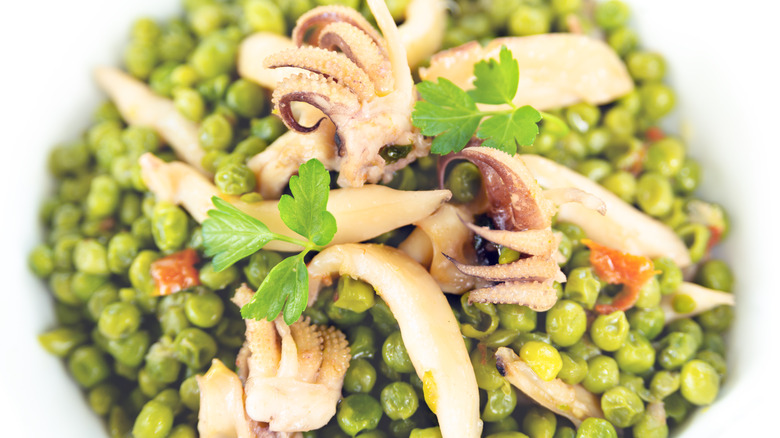A Beginner's Guide To Cuttlefish And How To Use It
If you are looking for a new way to enjoy seafood, you might want to try cuttlefish. Categorized as mollusks, cuttlefish have mushy, flexible bodies. Like squid, cuttlefish have two tentacles, which they use to hunt. Their eight remaining appendages are arms that they use to hold onto their food.
While cuttlefish can be enjoyed all over the world, they tend to inhabit waters that are relatively warm and shallow, avoiding depths lower than 650 feet. They especially seem to congregate in seagrass meadows and reefs. You are most likely to find these creatures in the waters surrounding Europe, Africa, Australia, and parts of Asia. Unfortunately, there aren't a ton of cuttlefish in the Americas, meaning that it's not always easy to find them fresh in your local supermarket.
The good news, however, is that plenty of cuttlefish are frozen on fishing boats shortly after they are captured. This allows professional chefs and home cooks alike to order them to their kitchens. They can then prepare this rich, umami-flavored mollusk in any number of ways, from on the grill to in the frying pan.
What do cuttlefish look like?
As cephalopods, cuttlefish have a head and a foot, which merge together to form their bodies. Their eight stubby arms and two long tentacles stem off their heads, forming a circular pattern. If you flip a cuttlefish over and look at the soft ring of flesh that lies beneath its arms, you'll see a round, hard beak. When in the wild, the animal uses this to help overpower its prey or even defend itself in brawls with larger ocean creatures. Folks who purchase fresh cuttlefish directly from the docks will probably notice the animal's eyes, which are quite prominent.
Interestingly, cuttlefish don't typically have one fixed color — they're one of the few animals that can shift their color. Cuttlefish have millions of chromatophores — or unique cells that function as if they were pixels running across the animal's exterior. The mollusks can control these cells so that they can blend into rocks or even frighten other sea animals. While frozen cuttlefish tend to be white, freshly caught cuttlefish can be light brown or even striped.
Are cuttlefish different from octopuses and squid?
Because cuttlefish have multiple arms and tentacles, some people might confuse them with octopuses or squid. However, they are their own unique order of animals. One of the primary differences between cuttlefish and these other cephalopods is the cuttlebone, an internal structure that helps cuttlefish float or sink. The cuttlebone can be divided roughly into two sections, one that contains water and one that contains gas. Depending on whether the cuttlefish wants to move up or down, the creature can use its cuttlebone to release or take in water, thus becoming more or less buoyant.
While cuttlefish take advantage of this neat physical feature, neither squid nor octopuses have cuttlebones. Instead, squid contain their own inner shell-like structure called the pen. Squid use this flexible structure not to control their buoyancy but rather to support their muscles and protect their organs. Meanwhile, octopuses lack any sort of shell, inner or otherwise.
Another major difference between cuttlefish and other cephalopods pertains to the respective shapes of their bodies. While cuttlefish have two tentacles and eight arms, octopuses have just the eight arms; some scientists have deemed the rear two to be used more akin to legs. Squid have the same number of arms and tentacles as cuttlefish; however, they are much sleeker and faster than their counterparts.
What do cuttlefish taste like?
Although cuttlefish have some characteristics that make them very different from squid, the two species have similar flavors. Like squid, cuttlefish can taste rich and creamy. They also have that chewy, slightly elastic texture that other cephalopods are so well known for. Interestingly, however, some culinary professionals prefer to serve cuttlefish over squid. Speaking to Delicious, John Susman, who hosts the podcast "Fishtales," explained: "I prefer cuttlefish to squid for sashimi. ... Fresh, raw cuttlefish has a texture and taste superior to squid."
Perhaps some of this preference stems from the fact that cuttlefish have a slightly more complex flavor than squid do. While squid tend to have a softer, less intense taste, cuttlefish offer a deeper, milkier flavor that also contains walnut notes. This added oomph means that you can easily substitute squid for cuttlefish as a way to elevate your seafood recipes. For example, you can amp up this baby saffron squid recipe by switching out the squid for its more flavorful alternative. Here, the richness of the cuttlefish meat will blend perfectly with the acidic white wine and pungent garlic cloves to make a plate that is absolutely luscious.
Where to buy cuttlefish
Cuttlefish are available for purchase in many different venues all around the world, although different countries permit fishing at different times of the year. In Portugal, for example, you can find these creatures fresh in municipal fish markets, especially during springtime when they are in season. You can also find them on ice in the supermarket pretty much year-round. Australian cuttlefish fishing, on the other hand, begins in mid-May, making fresh varieties more available in the Southern Hemisphere's winter months.
Meanwhile, in Japan, cuttlefish are captured for six months of the year, from October to April, via a process known as bottom trawling. The prevalence of this type of fishing means that several varieties of cuttlefish are often available in Japanese markets and online stores.
Although buying fresh cuttlefish is dependent on season and location, frozen cuttlefish can be enjoyed anywhere and at any time of the year. Online suppliers, like PanaPesca or FreshGoGo, will ship small orders of this product to your home for a relatively reasonable price. The best part is that online stores tend to sell a product that has already been trimmed and cleaned of ink. So, if you wanted to add some cuttlefish to a recipe, all you would have to do is defrost the ingredient and get cooking.
How to prepare cuttlefish
Since cuttlefish are popular in several different regions of the world, there are many unique ways to prepare them. In Japan, people enjoy making both squid and cuttlefish chips by drying out the meat and shredding it into smaller pieces. They then use the evaporated cuttlefish either as a type of bar snack or in recipes, as many home cooks enjoy sprinkling these chips over the top of their soups. You can try this tactic at home by preparing a grilled chicken ramen bowl and flavoring the broth with this delicious and crunchy surprise.
Alternatively, you could try a Portuguese dish and prepare chocos grelhados, or grilled cuttlefish. Simply throw your mollusks on the grill, douse them with olive oil, and season them with garlic and parsley. Here, the thick taste you get from a charcoal grill can accentuate the cuttlefish's naturally deep flavors. The olive oil and garlic combination also highlights the meat's natural succulence, leaving you with a thick, juicy meal.
For another interesting twist, you can always turn to an Australian method. Like in Portugal, many Aussies prefer to grill up their cuttlefish and dress it with plenty of oil and seasoning. However, they also serve it up with a generous portion of homemade mayonnaise.
Fried cuttlefish
If you are looking to elevate your fried squid recipe, you can swap in cuttlefish and bask in the results. Because cuttlefish is known for having a more complex taste than squid, you can fry up this ingredient to make a snack that's truly delectable. Here, the flavor of your meat won't be so easily drowned out by the thick layer of outer breading. Instead, you'll be able to taste the velvety richness of the cuttlefish combined with the oily goodness of the fried exterior. An added bonus is that cuttlefish are generally larger than tiny calamari, meaning that your fried cuttlefish will be served in larger, meatier hunks.
Interestingly, chocos fritos, or fried cuttlefish, are the regional specialty of the Portuguese city of Setúbal. To prepare your cuttlefish the Setúbal way, be sure to marinate them for at least an hour in a mixture of chili peppers, lemon juice, and salt. Then go ahead and bread your cuttlefish before frying them in a hot pan of olive oil. To ensure that the flavors of the marinated meat don't completely disappear, make sure to pat down your fried result with a paper towel thoroughly before serving. This will prevent the olive oil from overpowering the remainder of the ingredients.
Cuttlefish prepared in wine
It's not uncommon to hear of people enjoying a glass of wine with their seafood. However, when it comes to cuttlefish, you can actually cook your seafood in wine. In the Algarve, or the southernmost region of Portugal, the most popular cuttlefish preparation involves taking smaller specimens and cooking them in wine and garlic. You can try this at home by throwing a bunch of miniature cuttlefish into a frying pan filled with hot olive oil and crushed garlic. Then, you can go on to add the wine, although there is some debate as to how to do this.
In the Algarve, some people will wait until the end of the recipe to douse their piping hot cuttlefish in wine. This will give your final creation a strong flavor of vino, which will blend well with the creaminess of the cuttlefish. However, it won't necessarily eliminate all of the alcohol content from your plate, meaning you can't serve it to anyone under 21. To ensure that all the alcohol from the wine actually evaporates, some Portuguese cooks will add this ingredient earlier on, adding their vinho to the original pan of garlic-infused oil.
In terms of which wine to use in this recipe, there exists some debate. You can add white or even brandy, depending on whether you want your result to have a lighter or richer flavor.
Spicy cuttlefish
If you are looking to turn up the heat in the kitchen, look no further than these spicy cuttlefish preparations. In China, cooks spice up their cuttlefish by braising them in a mixture of powerful ingredients that could include hot peppers, soy sauce, and garlic. Since cuttlefish can absorb lots of juices, they will also pick up a lot of flavors from these other elements. The result will be a tender, succulent plate of cuttlefish that is spicy both inside and out.
For an alternative from Down Under, you can always turn to an Australian iteration of spicy BBQ cuttlefish. Rather than slow-cooking the meat in a pan of spicy ingredients, this version lets your cuttlefish absorb the spicy flavors of a marinade. Leave your cuttlefish to soak in a plate of cold chili peppers and garlic for two hours. Then, cook them on the grill. Like the Chinese version of this recipe, the Aussie interpretation relies on the succulent nature of cuttlefish flesh. Both recipes will give you a plate of hot and juicy meat.
Do cuttlefish taste better with or without ink?
Like squid and octopus, cuttlefish have ink that they release when they are under pressure in the wild. While not everyone is keen on eating a cephalopod's ink, some people really enjoy cuttlefish ink and even consider it a delicacy. The flavor of cuttlefish ink is deep, velvety, and full of umami. Because this taste is so complex, many people even buy full packages of ink to add to non-cuttlefish recipes.
Because of the depth that cuttlefish ink can bring to a recipe, in Portugal, it's common to prepare grilled cuttlefish without removing the inner ink sac. Grocery stores even sell uncleaned cuttlefish so that patrons can decide whether or not they want to use the ink in their recipes. That being said, some markets will clean the mollusk for their clients, upon request. Ultimately, eating cuttlefish with or without ink depends on personal taste. If you haven't made up your mind yet about which version you prefer, definitely try cuttlefish with ink at least once. It will likely be worth it.
How to clean a cuttlefish
For the most part, frozen cuttlefish are already sold with the ink sac and guts removed, so folks who are not interested in eating any ink might consider buying their products from the frozen section of the supermarket. However, if you are interested in preparing fresh cuttlefish — or if you want to serve the ink in rice or pasta — you will probably have to clean the creature yourself.
To prepare your cuttlefish for consumption, you will have to cut out both of the eyes, as well as its beak. Since the flesh of this creature is so rubbery, it's best to use a sharp knife. It's also recommended that you remove the cuttlebone, as the creature's ink sacs lie beneath this structure, toward the very center of its body. Once you locate this sac, cut around it, being very careful not to pierce it open. After removing the ink sac, you can slice a small hole into it, which will allow you to squeeze plenty of black liquid into a bowl. You can use this substance later to add a beautiful black color to another dish.
What recipes use cuttlefish ink?
Like squid ink, cuttlefish ink pairs well with a number of different meals, ranging from black noodle bowls to inky risottos. It is especially delicious in big plates of seafood rice or even paella, as a way to lend a bit of extra color and flavor to the meal. To turn your typical Spanish paella into a delicious black rice, start out by making this 30-minute paella recipe. Rather than adding broth to your rice, use water, as its flavor is more neutral. Right after you add this liquid to your rice dish, pour one sac of cuttlefish ink into your pan. This will give your paella a slightly salty umami taste, without overpowering the other ingredients.
Another popular way to use cuttlefish ink is by using it in pasta. While some people make black pasta by adding ink to fresh noodles, you can also add this dark liquid to your pasta sauce. One classic example of this is in spaghetti al nero di seppia, which is a type of noodle topped with a sauce involving onions, white wine, and cuttlefish ink. In this delightful combination, the acidity of the white wine helps open up the ocean flavors of the ink, creating a sauce that is rich yet balanced. You can serve this pasta plate with plenty of seafood toppings, like prawns, lobster, or even chopped cuttlefish.
Best sides to serve with cuttlefish
If you are planning a cuttlefish dinner, you can serve different sides, depending on how you prepare the main plate. Setúbal-style fried cuttlefish, for example, is considered a casual food to be enjoyed outdoors, especially near the beach. As a result, this delightful meal pairs well with a platter of French fries and a nice cold beer. To make your meal especially authentic, you can even serve it with one of the most popular "cervejas" in the country: Super Bock or Sagres.
On the other hand, if you are cooking up grilled cuttlefish, it is important to remember that this meal is slightly more formal. Because of this, you can serve it with one of the most traditional Portuguese sides: boiled potatoes and a mixed salad comprised of lettuce, tomatoes, and raw onions. Be sure to sprinkle all of your sides with some high-quality olive oil. For this stage, it is ideal to purchase a European brand of oil from a reliable source, as American extra-virgin olive oil tends to be much lower quality than the overseas alternative.
Serving cuttlefish as a side
Although you can serve cuttlefish with many different sides, this meat actually works well as a side. In Australia, cuttlefish are tossed into salads that can accompany a heavier meal, such as a grill-out or even a barbecue. For this method, marinate some small cuttlefish in spicy sauce and then throw them on the grill for a couple of minutes. Once they are brown and slightly crispy, you can use them as a topping for a light spring salad. This recipe is best served with a meatier main dish, as it provides an elegant way to start off a meal without ruining your guests' appetite.
For another delicious take on cuttlefish salad, start out by making this octopus salad, but substitute the octopus component for cuttlefish. Here, the saltiness of the olives and the sourness of the vinegar will accentuate the deeper flavors of the cuttlefish, all while keeping the final product light. Alternatively, you can serve sautéed cuttlefish on a bed of legumes, like peas or lentils, to make an ideal picnic lunch. Don't forget to squeeze a bit of lime juice over your final creation to keep the flavor light and summery.

